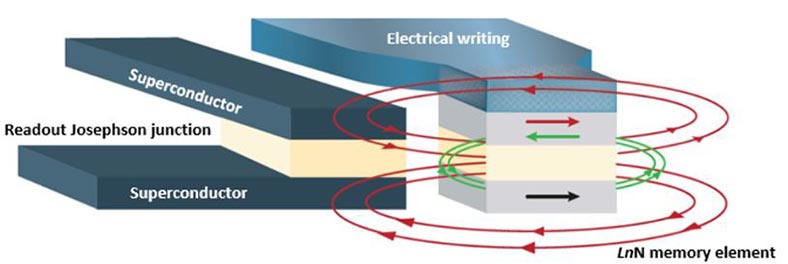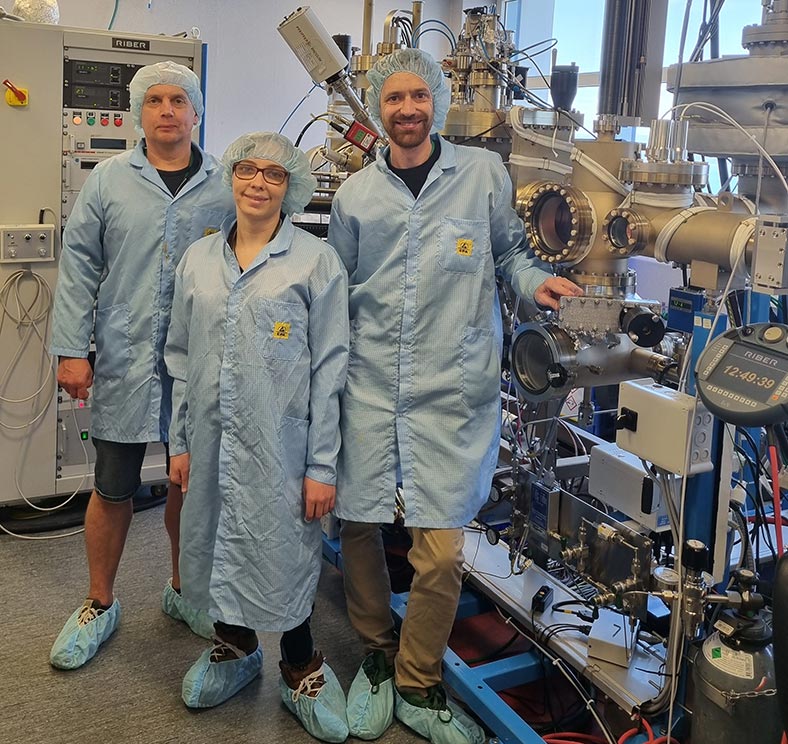Magnetic sandwiches for advanced computing - Annual Report 2024
14 June, 2025

Catherine and Will enjoy the laboratory work associated with investigating quantum materials. Here they are making adjustments on the ultra-high vaccuum chamber in which they make their magnetic sandwiches.
Quantum computing offers us the possibility of solving problems that can't be solved with classical computing, and superconducting computing promises extreme energy efficiency and higher speeds. But for these benefits to be delivered beyond experimental trials, breakthroughs are required.
Sure enough, behind the walls of two Pōneke Wellington laboratories, breakthroughs are being made. Physicists working as part of the Future Computing research programme at the MacDiarmid Institute are combining atoms in novel ways to create new materials for the next generation of computers.
Fresh from a PhD with the Spintronics Group at Te Herenga Waka Victoria University of Wellington (VUW), Dr Catherine Pot describes what she's been up to. "I've been making magnetic sandwiches. It's a bit like taking two flat, rectangular fridge magnets and putting a layer between them to stop them interacting with each other. When we point our fridge magnets in the same direction, they behave like a strong magnet. When we point them in the opposite direction to each other, then the two magnets cancel each other out. It's these two different states that can be used to signal 'zeros' and 'ones' in a memory device for computing. With our materials, we're doing this at the scale of microns and at the temperature of liquid helium."
Associate Investigator Dr William Holmes-Hewett of VUW's Paihau-Robinson Research Institute was one of Catherine's supervisors. He emphasises the scale of these 'sandwiches'. "They're unimaginably small. Looking down on them, they're a few microns in diameter - almost a hundred times smaller than the width of a human hair. Looking at them side on, you're getting down to a countable number of atoms high in each layer. We're building layers on the order of 5-50 nanometres thick." The reason for the tiny size is simple. Progress from storing a hundred megabytes of memory on the family computer back in the 1980s to one terabyte now - a ten-thousand-fold increase - comes from memory devices getting smaller. The more memory we want to store, the smaller the storage devices need to get to keep computers at a practical size.
As for the mind-blowingly cold temperatures these scientists are working with (liquid helium is minus 269 degrees Celsius), Will describes how this enables a well-controlled environment for quantum computations to operate in. "If you think about what heat is, it's just things shaking, atoms shaking, molecules shaking. When it is cold, atoms are not moving much at all, those are the conditions we need for manipulating quantum computing components."

Schematic diagram showing how a rare earth nitride magnetic sandwich (right-hand block of grey and cream layers) might be integrated with other superconducting componenents to become a memory element with read and write capabilities. Image by Gwen Hendry.
Catherine's magnetic sandwiches can act like a memory element in a computer because the orientation of the magnetic layers within the sandwiches can be switched between two different states. This memory device will work in conventional computing at regular temperatures, but because it also works at cryogenic temperatures, it has potential applications in superconducting and quantum computing as well.
So, what are these amazing sandwiches made of? The researchers have focused on a class of materials called the rare earth nitrides. Not only are they ferromagnetic, but they're also semiconductors. This combination of these two characteristics in one material is unusual as Catherine explains: "Most ferromagnetic materials are metals, so you've got limited control over the electrical properties. In our materials, we can choose the magnetic properties from the rare earth selection, and independently change the electrical properties according to the desired application."
In an ultra-high vacuum chamber that looks like a submarine, the scientists have been evaporating various combinations of rare earth elements like samarium and gadolinium in the presence of nitrogen to find the specific magnetic and electrical properties useful for future computing applications.
Memory has been one of the main roadblocks to upscaling and bringing quantum and superconducting computers out of the laboratory into the real world. Catherine and Will, with MacDiarmid Institute colleagues, demonstrated their prototype memory element in a 2023 paper1 in a world first. Will summarises, "This was the first memory element based on rare earth nitrides built for superconducting applications."

Ben, Catherine and Will with the Riber deposition system in the Spintronics laboratory at VUW. Protective clothing helps keep the environment clean which is crucial when making such small structures. Will says getting a piece of dust in the system would make their procedure like "trying to bake a cake with a watermelon in the cake tin".
Both Catherine and Will are proud of the heritage they are building on. Understanding rare earth nitrides has taken over two decades of work by the Spintronics Group at VUW (also known as the Rare Earth Nitrides Group and a long-standing part of the MacDiarmid Institute). Will says, "While other groups worldwide have experience in making superconducting devices, we're the leading group in terms of experience with these rare earth nitride materials. Our work is trying to apply novel materials to solve problems faced by traditional materials - quantum computers require cryogenic electronics that don't exist at the moment. We're trying to build those electronics here in New Zealand."
Will's fascination lies with investigating the fundamental electronic behaviour of the rare earth nitrides and putting that to good use. He's a rare breed of doing both computational and experimental work - his research benefits from the direct feedback and iterations between the computer and the laboratory.
...the team are actively working with national initiatives such as Quantum Technologies Aotearoa and with researchers in Japan, Italy, Australia and the US.
Catherine is living up to the award she won as a secondary school student - the Prime Minister's Future Scientist Prize in 2016. With an honours degree and now a PhD under her belt, she's keen to keep working in this field. There is still a lot of work required to move from laboratory-based demonstrations of these tri-layer sandwiches into a situation where they can be transported between labs and made to interface with other computing components.
Some of this will be explored in a 2024 MBIE Endeavour Fund programme, "Scalable cryogenic memory technology for superconducting and quantum computing," led by MacDiarmid Institute Principal Investigators Professor Ben Ruck, Head of the School of Chemical and Physical Sciences at VUW, and Dr Simon Granville, Principal Scientist at Paihau-Robinson Research Institute.
Collaboration is key to making breakthroughs in any field and the team are actively working with national initiatives such as Quantum Technologies Aotearoa and with researchers in Japan, Italy, Australia and the US. Will reflects, "What's really cool is that over the last 20 years the team at VUW has developed the fundamental knowledge to be able to use these rare earth materials in an exciting, applied setting and, because of that knowledge, we've made connections with groups who have complimentary expertise. Together we've been able to achieve something that none of us could do at the beginning."
- C. Pot, W. F. Holmes-Hewett, E.-M. Anton, J. D. Miller, B. J. Ruck, H. J. Trodahl; A nonvolatile memory element for integration with superconducting electronics. Appl. Phys. Lett. 13 November 2023; 123 (20): 202401. https://doi.org/10.1063/5.0175432


